Leadership & Management: Comprehensive Analysis of Fast Track's Plan
VerifiedAdded on 2023/06/11
|5
|812
|84
Report
AI Summary
This report provides a comprehensive analysis of Fast Track's business plan, evaluating its current business environment, objectives, and communication strategies. It examines the company's financial performance, operational goals, and stakeholder engagement methods. The report compares and contrasts different aspects of the business plan, highlighting both strengths and weaknesses in areas such as financial outflow analysis and stakeholder communication. Ultimately, the analysis aims to provide insights into Fast Track's strategic direction and potential for growth, referencing various sources on business models and communication to support its findings. Desklib offers a range of solved assignments and past papers for students.
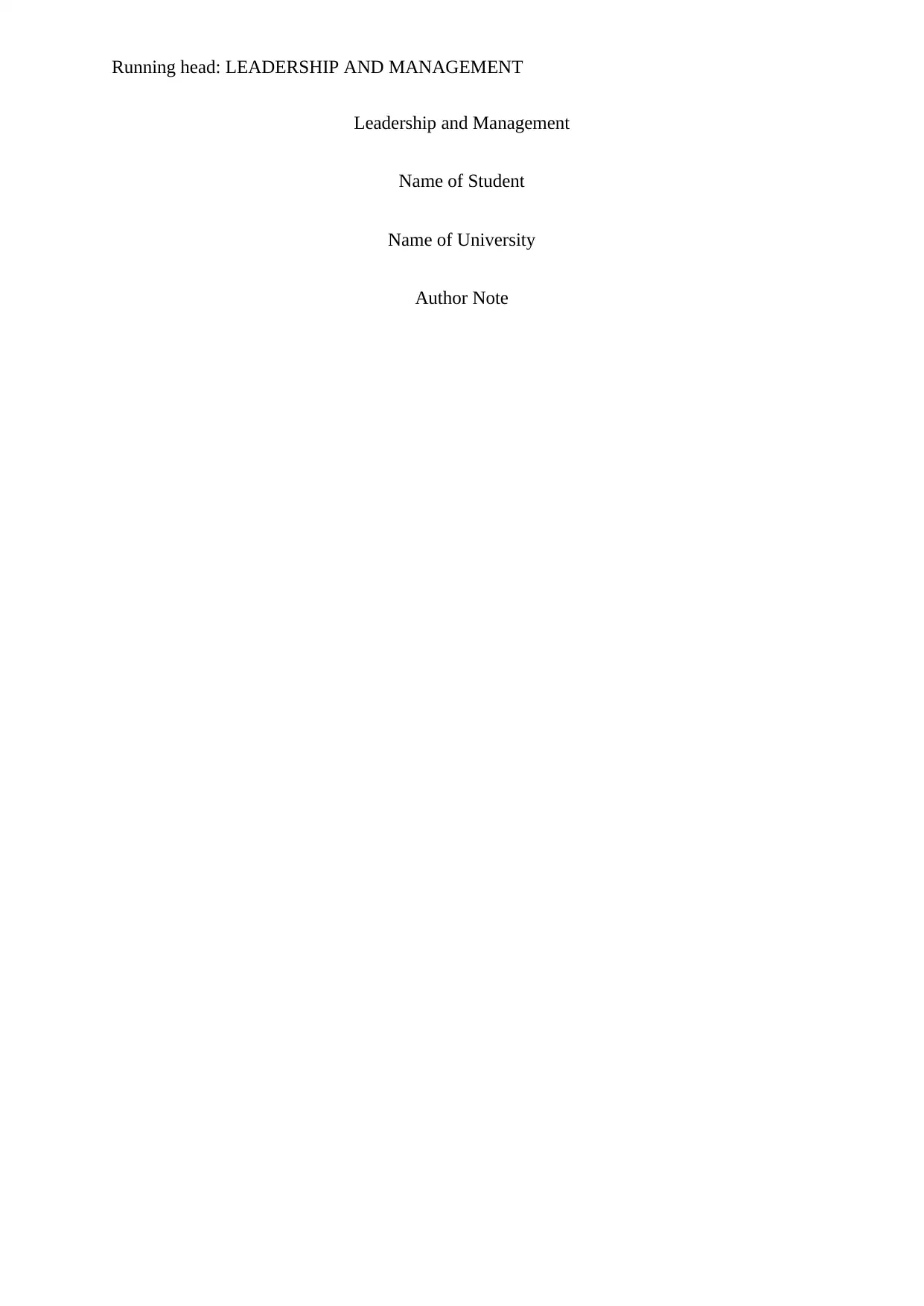
Running head: LEADERSHIP AND MANAGEMENT
Leadership and Management
Name of Student
Name of University
Author Note
Leadership and Management
Name of Student
Name of University
Author Note
Paraphrase This Document
Need a fresh take? Get an instant paraphrase of this document with our AI Paraphraser
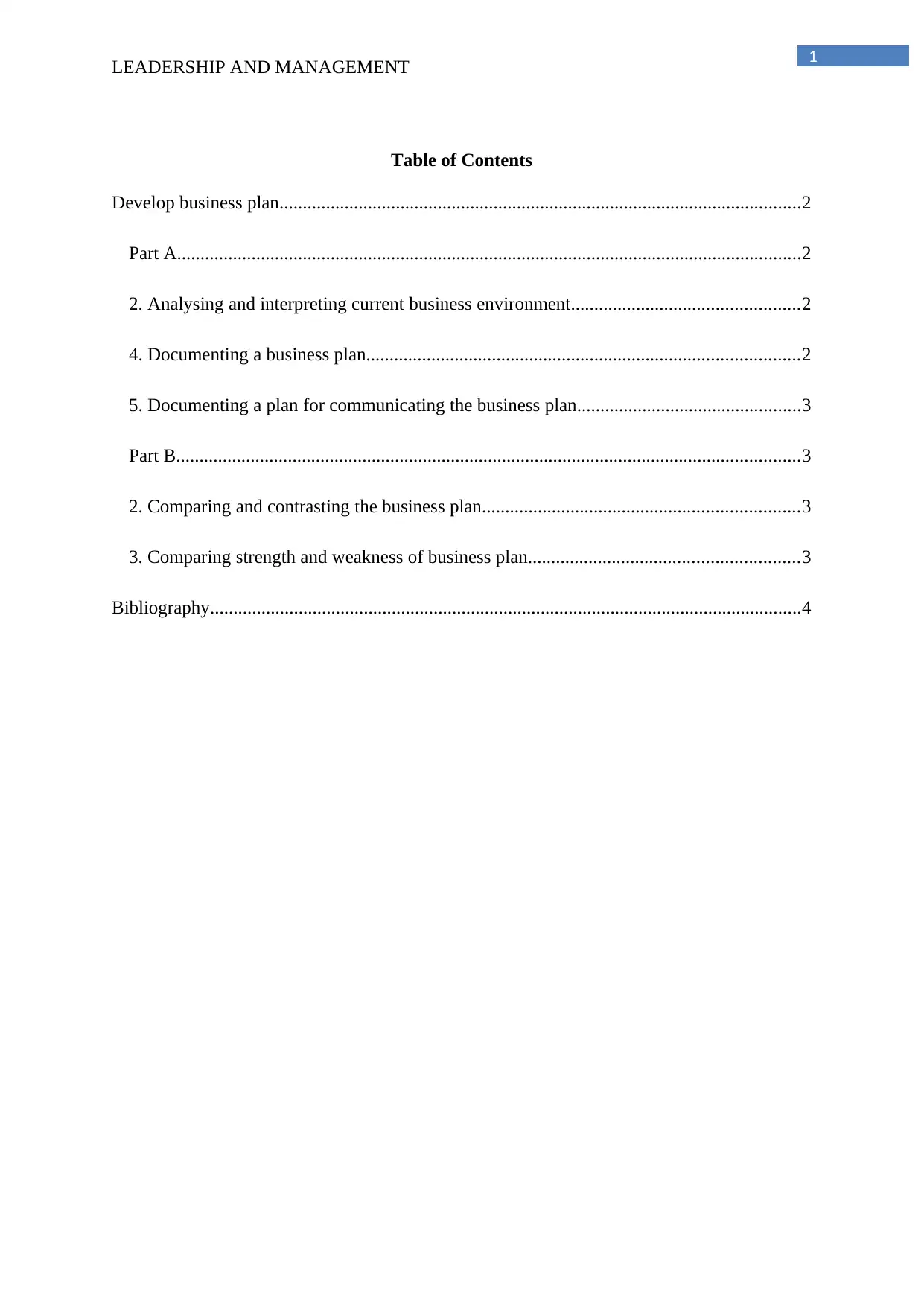
1
LEADERSHIP AND MANAGEMENT
Table of Contents
Develop business plan................................................................................................................2
Part A......................................................................................................................................2
2. Analysing and interpreting current business environment.................................................2
4. Documenting a business plan.............................................................................................2
5. Documenting a plan for communicating the business plan................................................3
Part B......................................................................................................................................3
2. Comparing and contrasting the business plan....................................................................3
3. Comparing strength and weakness of business plan..........................................................3
Bibliography...............................................................................................................................4
LEADERSHIP AND MANAGEMENT
Table of Contents
Develop business plan................................................................................................................2
Part A......................................................................................................................................2
2. Analysing and interpreting current business environment.................................................2
4. Documenting a business plan.............................................................................................2
5. Documenting a plan for communicating the business plan................................................3
Part B......................................................................................................................................3
2. Comparing and contrasting the business plan....................................................................3
3. Comparing strength and weakness of business plan..........................................................3
Bibliography...............................................................................................................................4
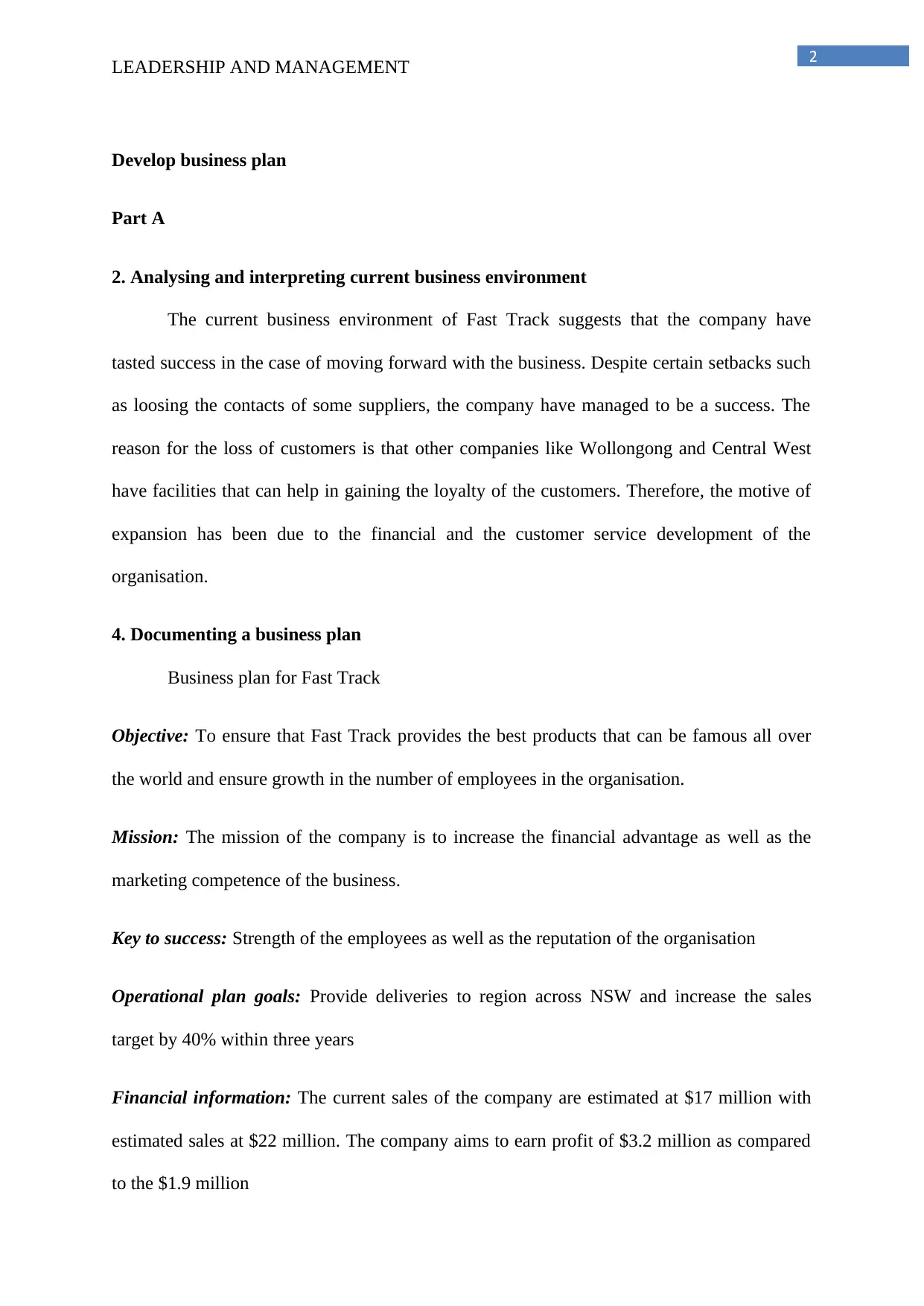
2
LEADERSHIP AND MANAGEMENT
Develop business plan
Part A
2. Analysing and interpreting current business environment
The current business environment of Fast Track suggests that the company have
tasted success in the case of moving forward with the business. Despite certain setbacks such
as loosing the contacts of some suppliers, the company have managed to be a success. The
reason for the loss of customers is that other companies like Wollongong and Central West
have facilities that can help in gaining the loyalty of the customers. Therefore, the motive of
expansion has been due to the financial and the customer service development of the
organisation.
4. Documenting a business plan
Business plan for Fast Track
Objective: To ensure that Fast Track provides the best products that can be famous all over
the world and ensure growth in the number of employees in the organisation.
Mission: The mission of the company is to increase the financial advantage as well as the
marketing competence of the business.
Key to success: Strength of the employees as well as the reputation of the organisation
Operational plan goals: Provide deliveries to region across NSW and increase the sales
target by 40% within three years
Financial information: The current sales of the company are estimated at $17 million with
estimated sales at $22 million. The company aims to earn profit of $3.2 million as compared
to the $1.9 million
LEADERSHIP AND MANAGEMENT
Develop business plan
Part A
2. Analysing and interpreting current business environment
The current business environment of Fast Track suggests that the company have
tasted success in the case of moving forward with the business. Despite certain setbacks such
as loosing the contacts of some suppliers, the company have managed to be a success. The
reason for the loss of customers is that other companies like Wollongong and Central West
have facilities that can help in gaining the loyalty of the customers. Therefore, the motive of
expansion has been due to the financial and the customer service development of the
organisation.
4. Documenting a business plan
Business plan for Fast Track
Objective: To ensure that Fast Track provides the best products that can be famous all over
the world and ensure growth in the number of employees in the organisation.
Mission: The mission of the company is to increase the financial advantage as well as the
marketing competence of the business.
Key to success: Strength of the employees as well as the reputation of the organisation
Operational plan goals: Provide deliveries to region across NSW and increase the sales
target by 40% within three years
Financial information: The current sales of the company are estimated at $17 million with
estimated sales at $22 million. The company aims to earn profit of $3.2 million as compared
to the $1.9 million
⊘ This is a preview!⊘
Do you want full access?
Subscribe today to unlock all pages.

Trusted by 1+ million students worldwide
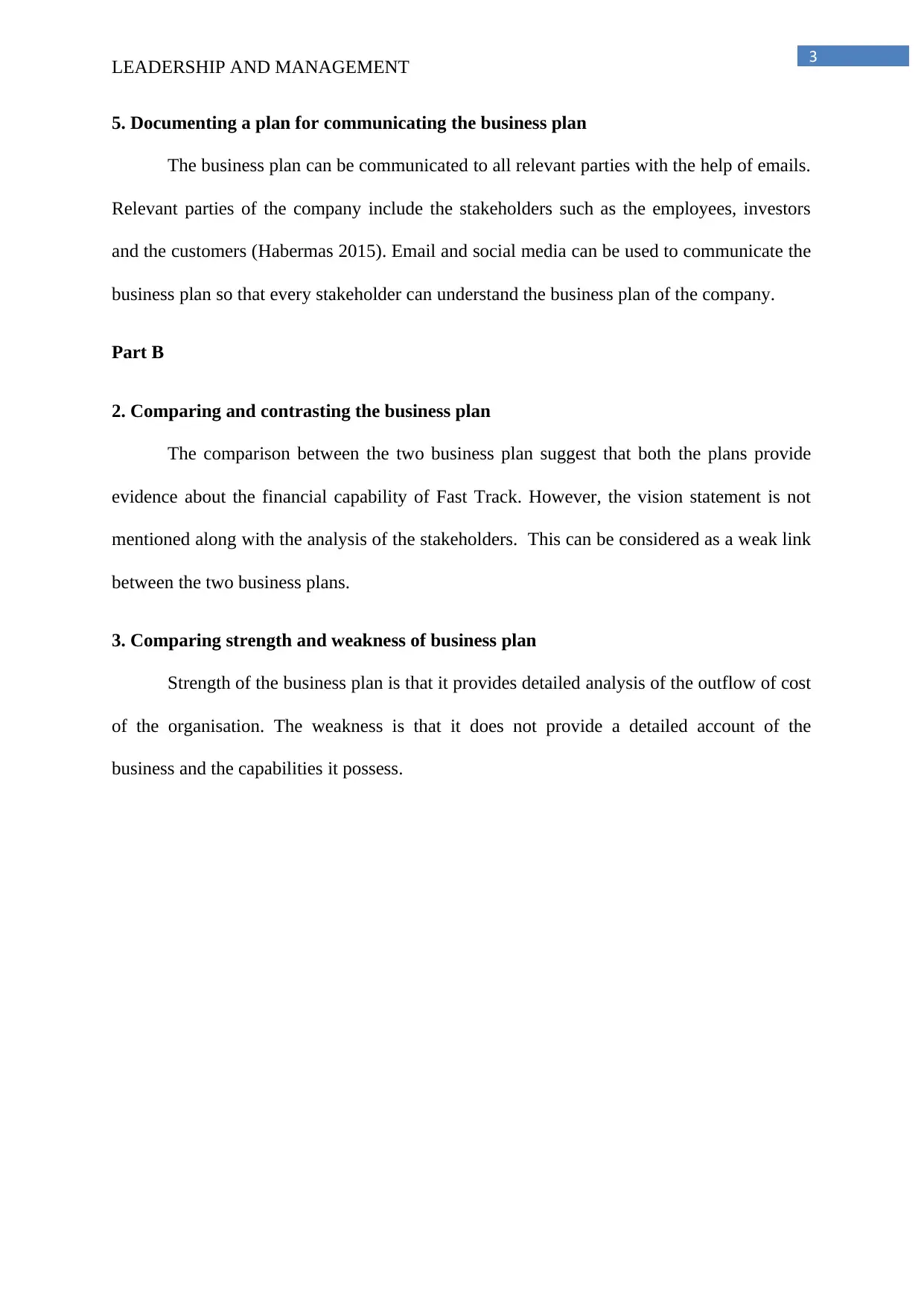
3
LEADERSHIP AND MANAGEMENT
5. Documenting a plan for communicating the business plan
The business plan can be communicated to all relevant parties with the help of emails.
Relevant parties of the company include the stakeholders such as the employees, investors
and the customers (Habermas 2015). Email and social media can be used to communicate the
business plan so that every stakeholder can understand the business plan of the company.
Part B
2. Comparing and contrasting the business plan
The comparison between the two business plan suggest that both the plans provide
evidence about the financial capability of Fast Track. However, the vision statement is not
mentioned along with the analysis of the stakeholders. This can be considered as a weak link
between the two business plans.
3. Comparing strength and weakness of business plan
Strength of the business plan is that it provides detailed analysis of the outflow of cost
of the organisation. The weakness is that it does not provide a detailed account of the
business and the capabilities it possess.
LEADERSHIP AND MANAGEMENT
5. Documenting a plan for communicating the business plan
The business plan can be communicated to all relevant parties with the help of emails.
Relevant parties of the company include the stakeholders such as the employees, investors
and the customers (Habermas 2015). Email and social media can be used to communicate the
business plan so that every stakeholder can understand the business plan of the company.
Part B
2. Comparing and contrasting the business plan
The comparison between the two business plan suggest that both the plans provide
evidence about the financial capability of Fast Track. However, the vision statement is not
mentioned along with the analysis of the stakeholders. This can be considered as a weak link
between the two business plans.
3. Comparing strength and weakness of business plan
Strength of the business plan is that it provides detailed analysis of the outflow of cost
of the organisation. The weakness is that it does not provide a detailed account of the
business and the capabilities it possess.
Paraphrase This Document
Need a fresh take? Get an instant paraphrase of this document with our AI Paraphraser
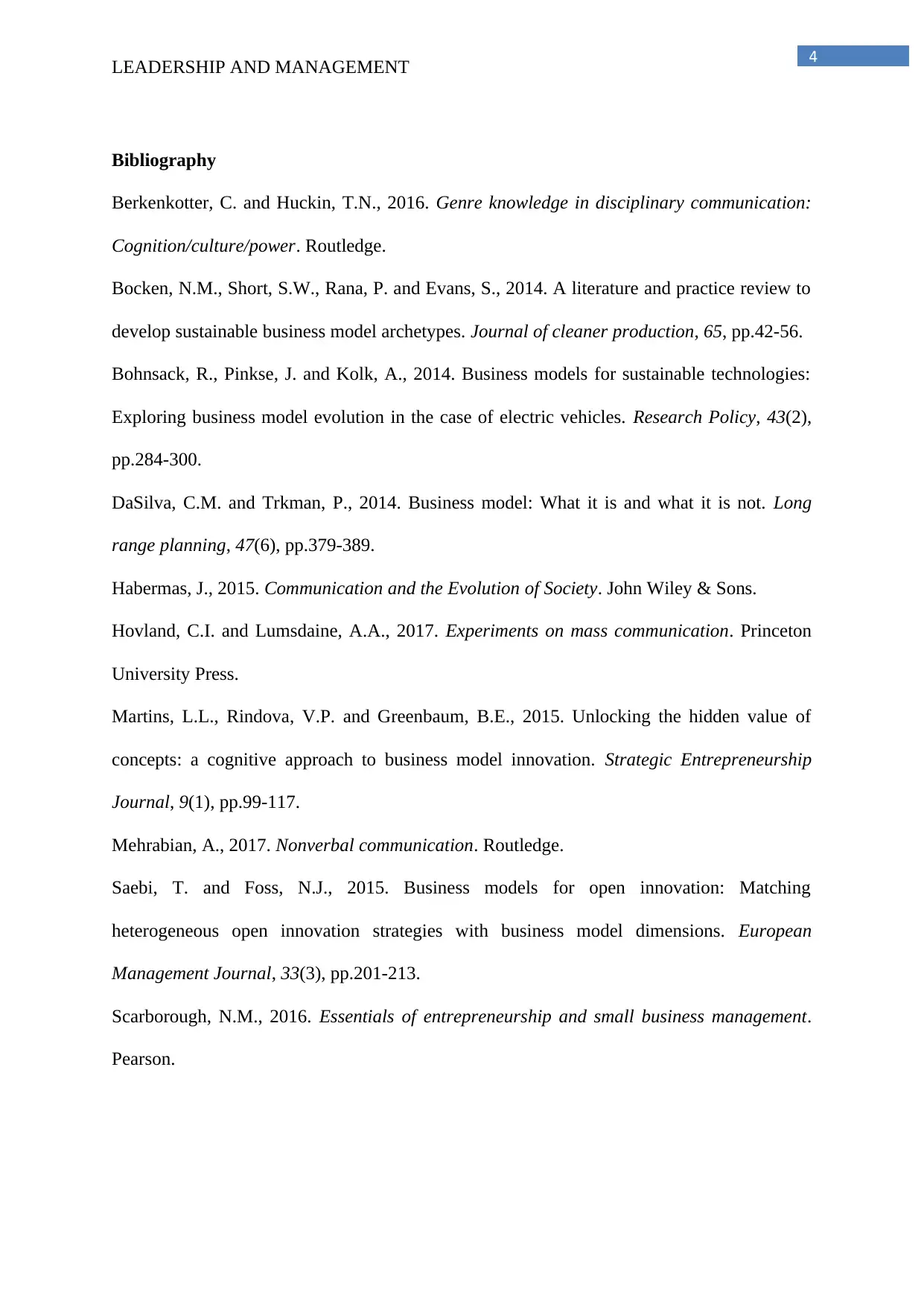
4
LEADERSHIP AND MANAGEMENT
Bibliography
Berkenkotter, C. and Huckin, T.N., 2016. Genre knowledge in disciplinary communication:
Cognition/culture/power. Routledge.
Bocken, N.M., Short, S.W., Rana, P. and Evans, S., 2014. A literature and practice review to
develop sustainable business model archetypes. Journal of cleaner production, 65, pp.42-56.
Bohnsack, R., Pinkse, J. and Kolk, A., 2014. Business models for sustainable technologies:
Exploring business model evolution in the case of electric vehicles. Research Policy, 43(2),
pp.284-300.
DaSilva, C.M. and Trkman, P., 2014. Business model: What it is and what it is not. Long
range planning, 47(6), pp.379-389.
Habermas, J., 2015. Communication and the Evolution of Society. John Wiley & Sons.
Hovland, C.I. and Lumsdaine, A.A., 2017. Experiments on mass communication. Princeton
University Press.
Martins, L.L., Rindova, V.P. and Greenbaum, B.E., 2015. Unlocking the hidden value of
concepts: a cognitive approach to business model innovation. Strategic Entrepreneurship
Journal, 9(1), pp.99-117.
Mehrabian, A., 2017. Nonverbal communication. Routledge.
Saebi, T. and Foss, N.J., 2015. Business models for open innovation: Matching
heterogeneous open innovation strategies with business model dimensions. European
Management Journal, 33(3), pp.201-213.
Scarborough, N.M., 2016. Essentials of entrepreneurship and small business management.
Pearson.
LEADERSHIP AND MANAGEMENT
Bibliography
Berkenkotter, C. and Huckin, T.N., 2016. Genre knowledge in disciplinary communication:
Cognition/culture/power. Routledge.
Bocken, N.M., Short, S.W., Rana, P. and Evans, S., 2014. A literature and practice review to
develop sustainable business model archetypes. Journal of cleaner production, 65, pp.42-56.
Bohnsack, R., Pinkse, J. and Kolk, A., 2014. Business models for sustainable technologies:
Exploring business model evolution in the case of electric vehicles. Research Policy, 43(2),
pp.284-300.
DaSilva, C.M. and Trkman, P., 2014. Business model: What it is and what it is not. Long
range planning, 47(6), pp.379-389.
Habermas, J., 2015. Communication and the Evolution of Society. John Wiley & Sons.
Hovland, C.I. and Lumsdaine, A.A., 2017. Experiments on mass communication. Princeton
University Press.
Martins, L.L., Rindova, V.P. and Greenbaum, B.E., 2015. Unlocking the hidden value of
concepts: a cognitive approach to business model innovation. Strategic Entrepreneurship
Journal, 9(1), pp.99-117.
Mehrabian, A., 2017. Nonverbal communication. Routledge.
Saebi, T. and Foss, N.J., 2015. Business models for open innovation: Matching
heterogeneous open innovation strategies with business model dimensions. European
Management Journal, 33(3), pp.201-213.
Scarborough, N.M., 2016. Essentials of entrepreneurship and small business management.
Pearson.
1 out of 5
Related Documents
Your All-in-One AI-Powered Toolkit for Academic Success.
+13062052269
info@desklib.com
Available 24*7 on WhatsApp / Email
![[object Object]](/_next/static/media/star-bottom.7253800d.svg)
Unlock your academic potential
Copyright © 2020–2025 A2Z Services. All Rights Reserved. Developed and managed by ZUCOL.




